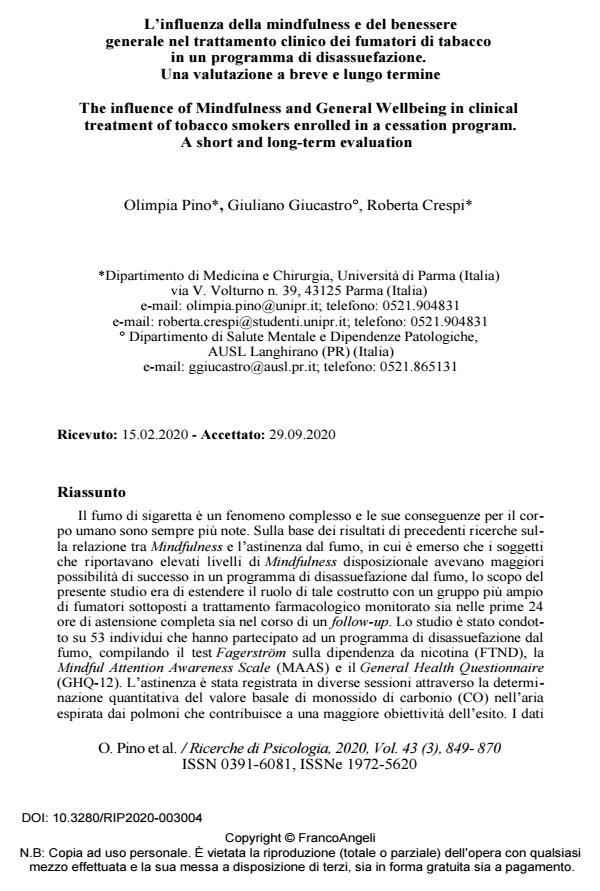The influence of Mindfulness and General Wellbeing in clinical treatment of tobacco smokers enrolled in a cessation program. A short and long-term evaluation
Journal title RICERCHE DI PSICOLOGIA
Author/s Olimpia Pino, Giuliano Giucastro, Roberta Crespi
Publishing Year 2020 Issue 2020/3
Language Italian Pages 22 P. 849-870 File size 279 KB
DOI 10.3280/RIP2020-003004
DOI is like a bar code for intellectual property: to have more infomation
click here
Below, you can see the article first page
If you want to buy this article in PDF format, you can do it, following the instructions to buy download credits

FrancoAngeli is member of Publishers International Linking Association, Inc (PILA), a not-for-profit association which run the CrossRef service enabling links to and from online scholarly content.
Cigarette smoking is a complex phenomenon and its consequences for hu-man body are increasingly known. Basing on the results from previous research on relationship between Mindfulness and smoking abstinence in which it emer-ged that subjects who had high levels of dispositional Mindfulness had a greater chance of success in a smoking cessation program, the aim of the present study was to extend the analysis in a larger group of individuals subjected to pharma-cological treatment and motivational counselling, which were monitored both at the first 24-h of complete abstention and at the follow-up. The study involved 53 individuals who participated to a smoke cessation program completing the Fa-gerström Test of Nicotine Dependence (FTND), the Mindful Attention Awareness Scale (MAAS) and the General Health Questionnaire (GHQ-12). Abstinence was recorded in several sessions also through the quantitative determination of the value of carbon monoxide on the expired air (CO) from the lungs that contribu-tes to a greater objectivity of the outcome measure. Data did not confirm the role of Mindfulness as a predictor of abstinence. MAAS and GHQ-12 scores did not result in relationship with the outcome of nicotine cessation program. Therefore, Mindfulness construct would seem not to be a predictor of success in a smoking cessation program. The use of more sensitive tools in detecting the Mindfulness trait could lead to appropriate results as a more structured cognitive behavioural treatment could be contributing to support habitual smokers quit.
Keywords: Nicotine addiction, tobacco addiction, smoking, smoke cessation programs, mindfulness.
Olimpia Pino, Giuliano Giucastro, Roberta Crespi, L’influenza della mindfulness e del benessere generale nel trattamento clinico dei fumatori di tabacco in un programma di disassuefazione. Una valutazione a breve e lungo termine in "RICERCHE DI PSICOLOGIA " 3/2020, pp 849-870, DOI: 10.3280/RIP2020-003004